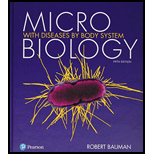
Concept explainers
(1)
To determine:
What the man suffered from; what the antibodies were against; what the dark-staining bodies in his brains cells were; what the preventive measures are that might be used by the healthcare workers to save the man’s life.
Case summary:
A man with a neurological disorder (anxiety, feelings of fear, and unrestrained facial twitching) reached an emergency room. He also developed swallowing difficulties, itching, and sore throat. He negated to drink water due to swallowing difficulties. He frequently vomited and his body temperature is increased (106ºF). He died after being admitted in the hospital for one week. Increased antibody titer (blood) and dark-staining bodies (brain cells) are discovered after the autopsy. Through investigations, his family and friends mentioned that a bat had landed on his face.
(2)
To determine:
What the antibodies were against.
Case summary:
A man with a neurological disorder (anxiety, feelings of fear, and unrestrained facial twitching) reached an emergency room. He also developed swallowing difficulties, itching, and sore throat. He negated to drink water due to swallowing difficulties. He frequently vomited and his body temperature is increased (106ºF). He died after being admitted in the hospital for one week. Increased antibody titer (blood) and dark-staining bodies (brain cells) are discovered after the autopsy. Through investigations, his family and friends mentioned that a bat had landed on his face.
(3)
To determine:
What the dark-staining bodies in his brains cells were.
Case summary:
A man with a neurological disorder (anxiety, feelings of fear, and unrestrained facial twitching) reached an emergency room. He also developed swallowing difficulties, itching, and sore throat. He negated to drink water due to swallowing difficulties. He frequently vomited and his body temperature is increased (106ºF). He died being admitted in the hospital for after one week. Increased antibody titer (blood) and dark-staining bodies (brain cells) are discovered after the autopsy. Through investigations, his family and friends mentioned that a bat had landed on his face.
(4)
To determine:
What the preventive measures are that might be used by the healthcare workers to save the man’s life.
Case summary:
A man with a neurological disorder (anxiety, feelings of fear, and unrestrained facial twitching) reached an emergency room. He also developed swallowing difficulties, itching, and sore throat. He negated to drink water due to swallowing difficulties. He frequently vomited and his body temperature is increased (106ºF). He died after being admitted in the hospital for one week. Increased antibody titer (blood) and dark-staining bodies (brain cells) are discovered after the autopsy. Through investigations, his family and friends mentioned that a bat had landed on his face.
Want to see the full answer?
Check out a sample textbook solution
Chapter 20 Solutions
Pearson eText Bauman Microbiology with Diseases by Body Systems -- Instant Access (Pearson+)
- Molecular Biology Question You are working to characterize a novel protein in mice. Analysis shows that high levels of the primary transcript that codes for this protein are found in tissue from the brain, muscle, liver, and pancreas. However, an antibody that recognizes the C-terminal portion of the protein indicates that the protein is present in brain, muscle, and liver, but not in the pancreas. What is the most likely explanation for this result?arrow_forwardMolecular Biology Explain/discuss how “slow stop” and “quick/fast stop” mutants wereused to identify different protein involved in DNA replication in E. coli.arrow_forwardMolecular Biology Question A gene that codes for a protein was removed from a eukaryotic cell and inserted into a prokaryotic cell. Although the gene was successfully transcribed and translated, it produced a different protein than it produced in the eukaryotic cell. What is the most likely explanation?arrow_forward
- Molecular Biology LIST three characteristics of origins of replicationarrow_forwardMolecular Biology Question Please help. Thank you For E coli DNA polymerase III, give the structure and function of the b-clamp sub-complex. Describe how the structure of this sub-complex is important for it’s function.arrow_forwardMolecular Biology LIST three characteristics of DNA Polymerasesarrow_forward
- Molecular Biology RNA polymerase core enzyme structure contains what subunits? To form holo enzyme, sigma factor is added to core. What is the name of the structure formed? Give the detailed structure of sigma factor and the function of eachdomain. Please help. Thank youarrow_forwardMolecular Biology You have a single bacterial cell whose DNA is labelled with radioactiveC14. After 5 rounds of cell division, how may cells will contain radioactive DNA? Please help. Thank youarrow_forward1. Explain the structure and properties of atoms and chemical bonds (especially how they relate to DNA and proteins). Also add some pictures.arrow_forward
- 1. In the Sentinel Cell DNA integrity is preserved through nanoscopic helicase-coordinated repair, while lipids in the membrane are fortified to resist environmental mutagens. also provide pictures for this question.arrow_forwardExplain the structure and properties of atoms and chemical bonds (especially how they relate to DNA and proteins). Also add some pictures.arrow_forwardIn the Sentinel Cell DNA integrity is preserved through nanoscopic helicase-coordinated repair, while lipids in the membrane are fortified to resist environmental mutagens. also provide pictures for this question.arrow_forward
- Lifetime Physical Fitness & WellnessHealth & NutritionISBN:9781337677509Author:HOEGERPublisher:Cengage
 Comprehensive Medical Assisting: Administrative a...NursingISBN:9781305964792Author:Wilburta Q. Lindh, Carol D. Tamparo, Barbara M. Dahl, Julie Morris, Cindy CorreaPublisher:Cengage Learning
Comprehensive Medical Assisting: Administrative a...NursingISBN:9781305964792Author:Wilburta Q. Lindh, Carol D. Tamparo, Barbara M. Dahl, Julie Morris, Cindy CorreaPublisher:Cengage Learning Medical Terminology for Health Professions, Spira...Health & NutritionISBN:9781305634350Author:Ann Ehrlich, Carol L. Schroeder, Laura Ehrlich, Katrina A. SchroederPublisher:Cengage LearningUnderstanding Health Insurance: A Guide to Billin...Health & NutritionISBN:9781337679480Author:GREENPublisher:Cengage
Medical Terminology for Health Professions, Spira...Health & NutritionISBN:9781305634350Author:Ann Ehrlich, Carol L. Schroeder, Laura Ehrlich, Katrina A. SchroederPublisher:Cengage LearningUnderstanding Health Insurance: A Guide to Billin...Health & NutritionISBN:9781337679480Author:GREENPublisher:Cengage





